Your LinkedIn page is basically your digital resume, portfolio, and cover letter all wrapped into one. When you’re filling out your profile with your many accolades, be sure you’re not skipping a valuable piece of real estate: your LinkedIn banner.
Now, to be clear, recruiters might not even see the banner. Bonnie Dilber, Senior Manager of Talent Acquisition at Zapier, told me that recruiters won’t see your banner if they’re using LinkedIn Recruiter, for example. But Bonnie also said that sometimes she’ll click through—and when she sees the full profile, the banner can give her a sense of a person’s values and interests.
So not including a banner likely won’t deter recruiters from reaching out, but it’s still a great place to showcase some personality—and might just be the perfect conversation starter.
Unsure what image to upload as your LinkedIn banner? You’re not alone—while stalking profiles for this article, I noticed roughly half of the profiles I came across stuck with the default image featured below (sorry, Blake). So I’ve compiled a list of the best LinkedIn banner ideas that stuck out to me—and to the recruiters at Zapier—to help you stand out from the crowd.
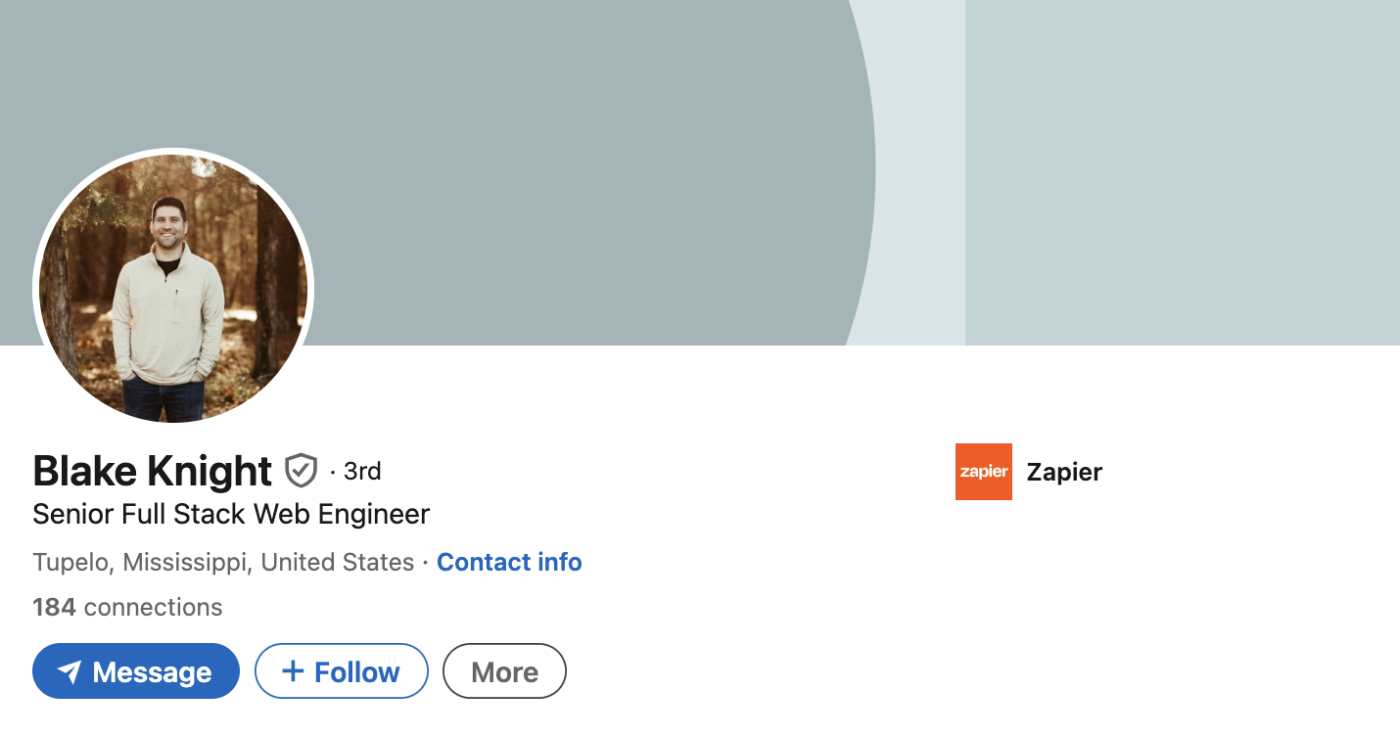
Table of contents:
1. City skyline
If your career is closely tied to the city you work in, slap the city skyline on your profile. For example, if you lead a tour guide company out of New York City, will people trust you more if your background is a random abstract image or an amazing shot of the Statue of Liberty?
Even if your location isn’t relevant to your work, it can still show your connection to a specific place and help spark folks to reach out about local events. Here’s an example from full stack recruiter and HR professional Mia showing off the skyline of Vancouver.
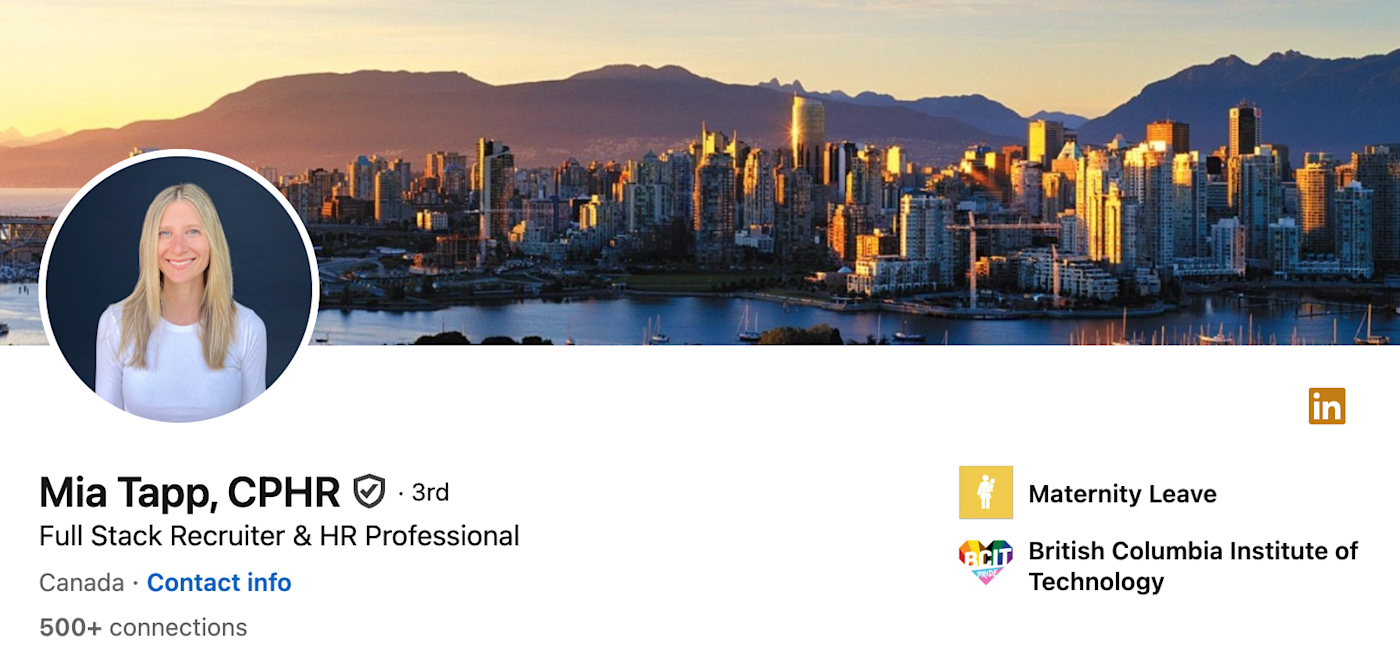
2. City landmark or natural landscape
Just like the city skyline, a local landmark can help identify your location at a glance and serve as a fun way to get the conversation going. Elsie, an Associate Director at Siege Media, features the iconic La Jolla coastline in her LinkedIn banner. It gives a clear nod to her San Diego roots and offers a personal touch that invites connection.
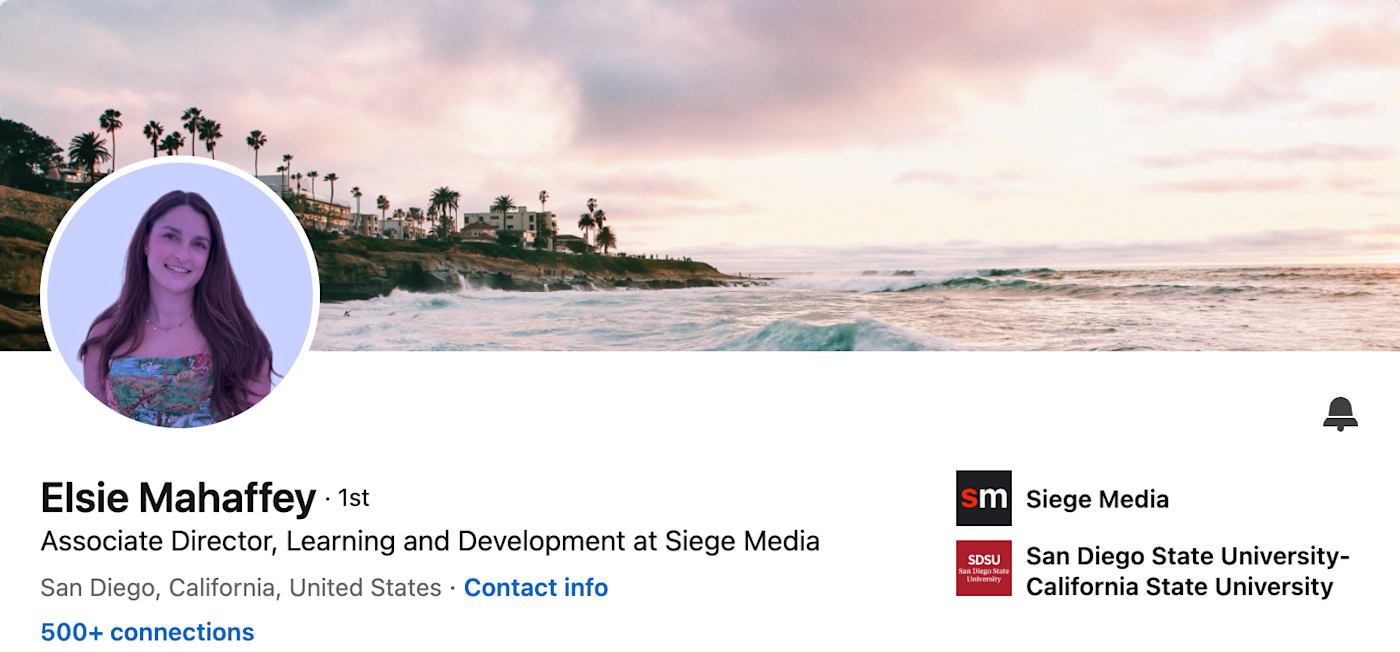
Here’s another example from Briana at Grammarly, who uses a banner photo of the Golden Gate Bridge to showcase her love for San Francisco. It’s a bold, recognizable landmark that instantly anchors her profile in the Bay Area and adds a personal touch that helps break the ice.
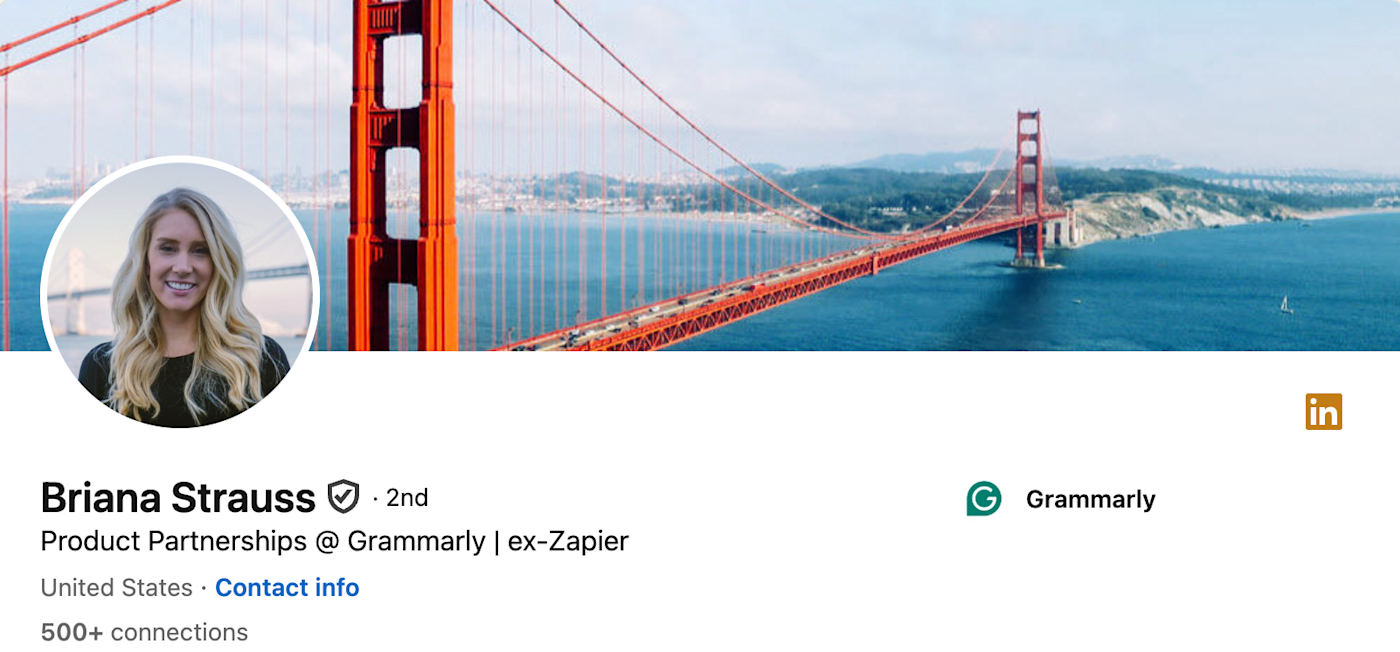
3. Inspirational quote or motto
An inspirational quote (by you or someone you admire) or a personal motto can showcase your values and personality to future employers during the job search or to prospective clients.
My personal favorite quote is “There is no innovation and creativity without failure. Period.” from Brené Brown because it inspires me to take risks. Whatever quote you choose, be sure it encompasses who you are as an individual and in your career.
Rachael, a manager on the Technical Support Operations team at Zapier, sticks with something anonymous—and spices it up by displaying it in lights.
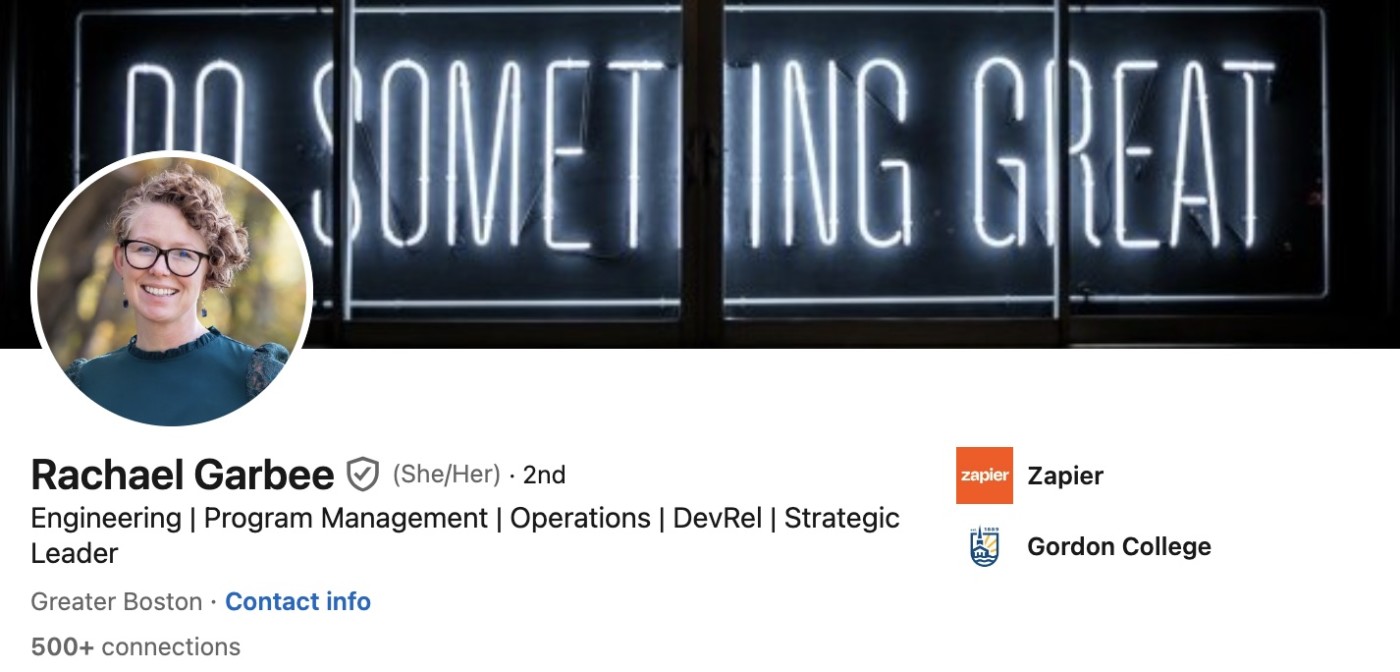
4. Daily work
Featuring visual elements that reflect your daily work and professional identity can add some credibility to your profile and snapshot of who you are and what you do.
In the example below, Lindsey, an editor at Zapier, shows off her pen, paper, and (of course) coffee while maintaining a cohesive black and white aesthetic, which highlights her eye for design.
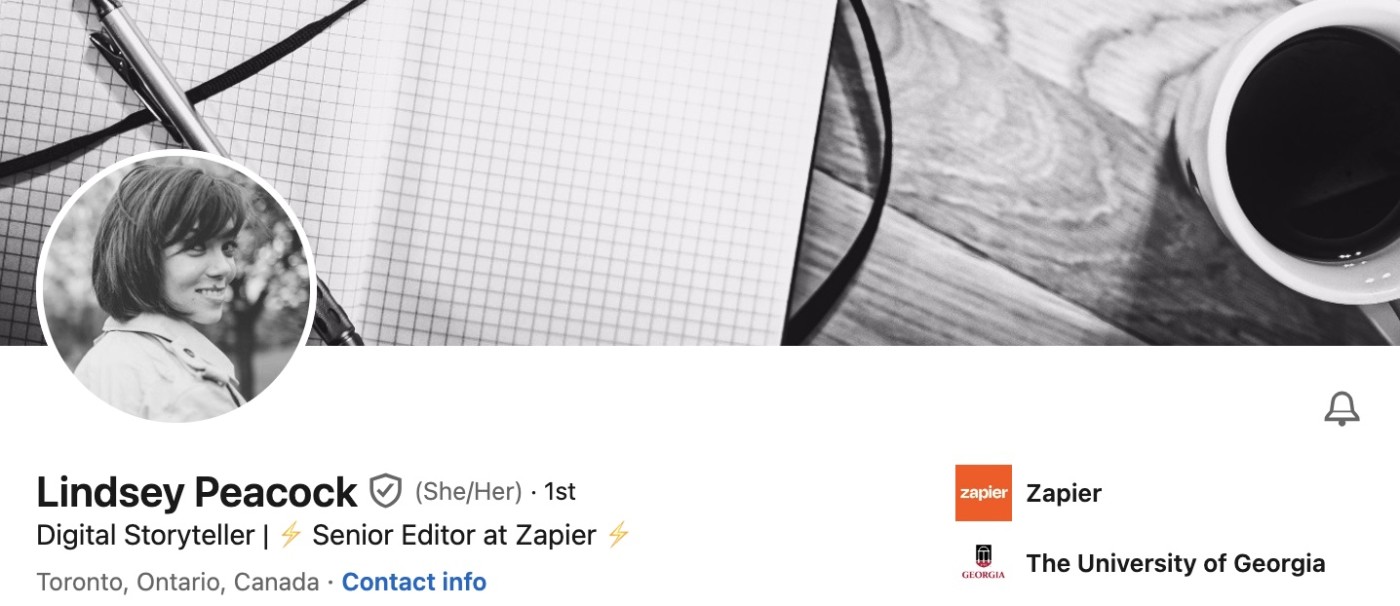
And you can tell that Claire, a registered nurse, is passionate about her field just by glancing at her LinkedIn banner, which features a black-and-white photo of a healthcare professional caring for children.
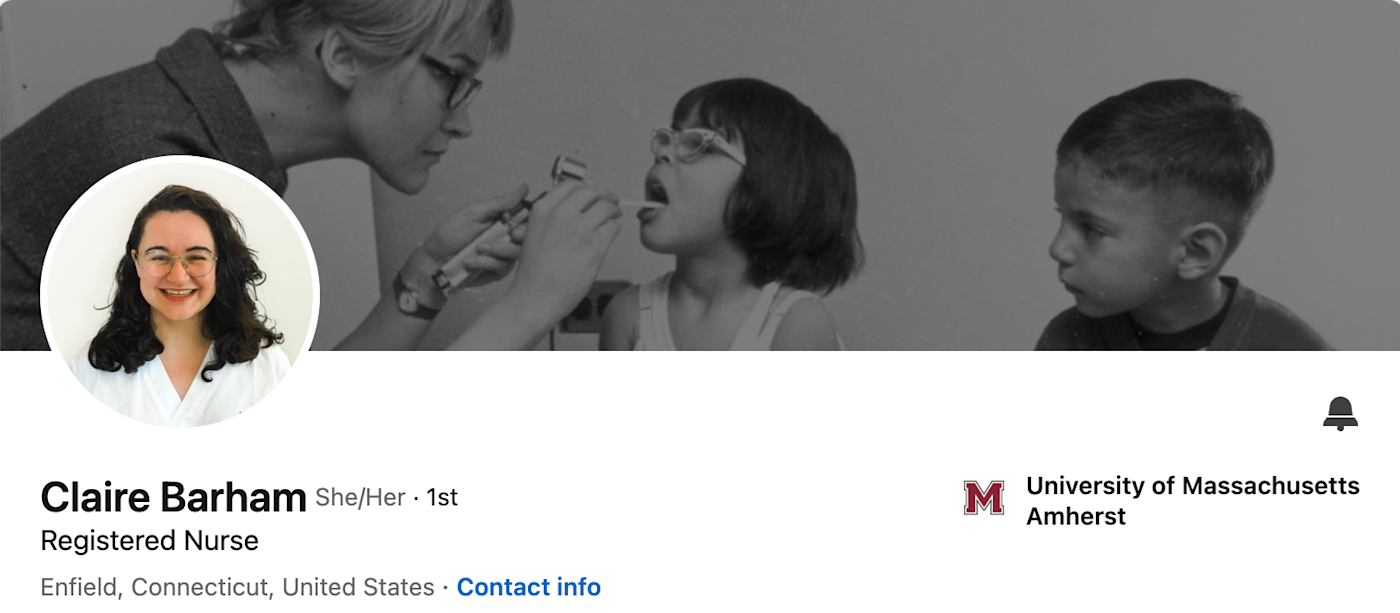
5. Graph
If you have a data- or results-driven career (think data engineer or sales manager), consider an image showing upward trend lines and other visualizations frequently used in your line of work. Don’t shy away from using bold colors that really grab attention to showcase your creativity.
Paulie, Chief Marketing Officer at AG1, grabs your attention with a timeline visualizing key milestones in AG1’s product evolution. You can tell he loves what he does.
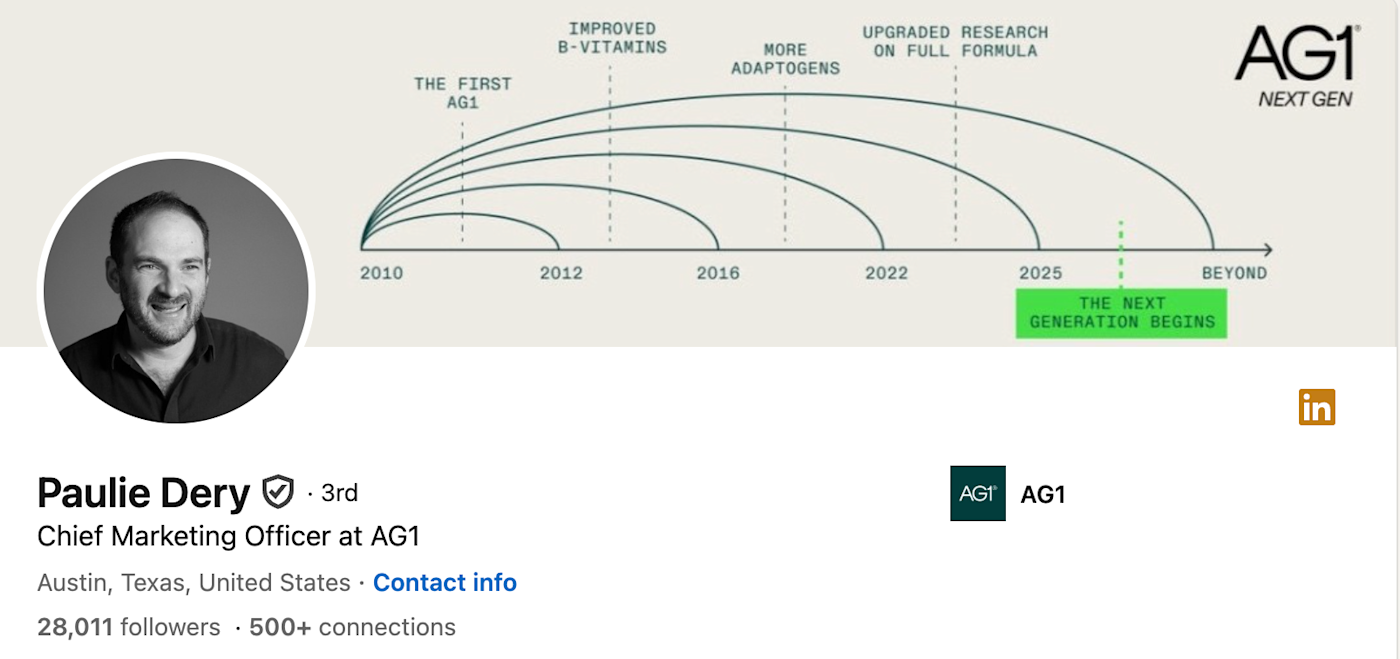
6. Your company, coworkers, or clients
If your job involves working with people, like HR or customer success, add an image of the folks you work with. If you don’t have an in-person picture, you can also use an illustrated image to portray that you’re a people-oriented professional.
Here’s a picture of the entire Zapier team at an in-person retreat, care of Shane, a Senior Technical Support Specialist at Zapier.
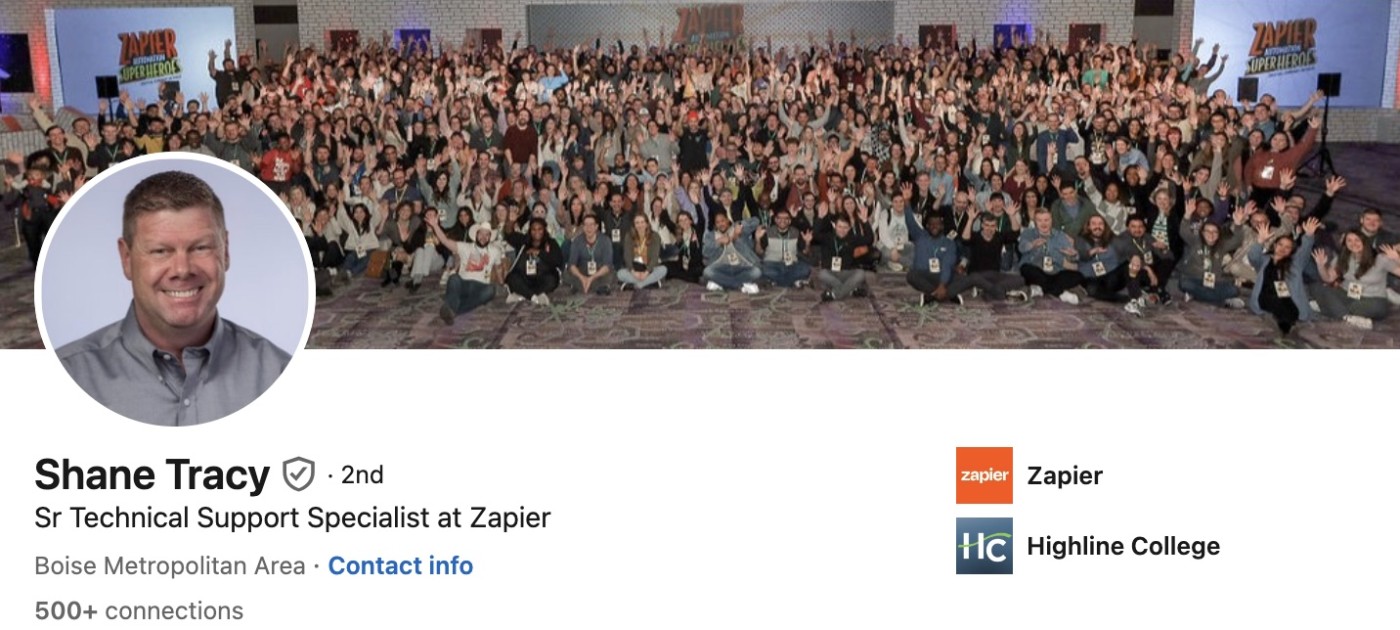
7. Personal hobby or interest
Your LinkedIn banner can be a great place to showcase what you like to do outside of work too. Recruiters are looking for a well-rounded person, and adding a personal hobby or interest shows that you’re a real person, not just a resume. Whether it’s a photo of you doing something you love or just an image of whatever you’re a die-hard fan of, including this on your profile can be a nice personal touch—and will absolutely get some conversations going.
I’d be shocked to find out that Russell, a talent sourcer and data analyst at Microsoft, didn’t love car racing.
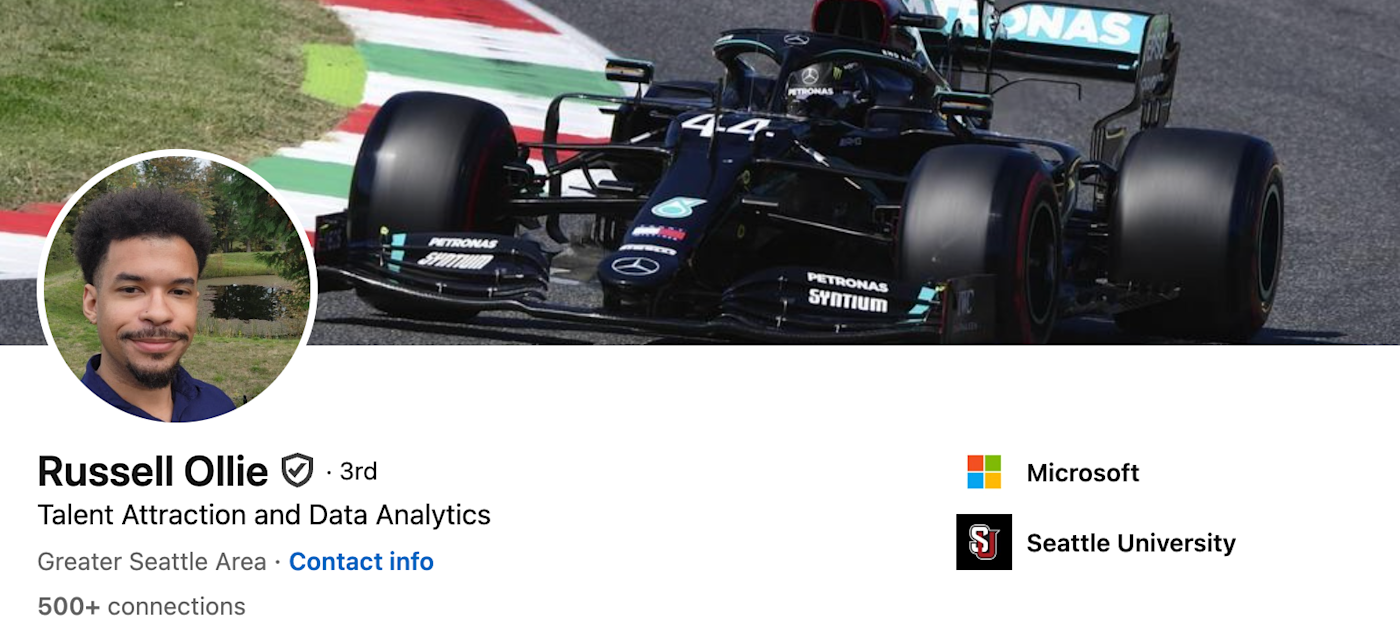
8. Workstation
A photo of your desk and work setup gives off a clean, professional vibe.
You can even use this image as a background to display your name, job title, or contact information, like Ashley, a freelance content specialist, does in the example below. Her cohesive color scheme creates a distinct personal brand, which is especially important for creative roles like content writers and graphic designers.
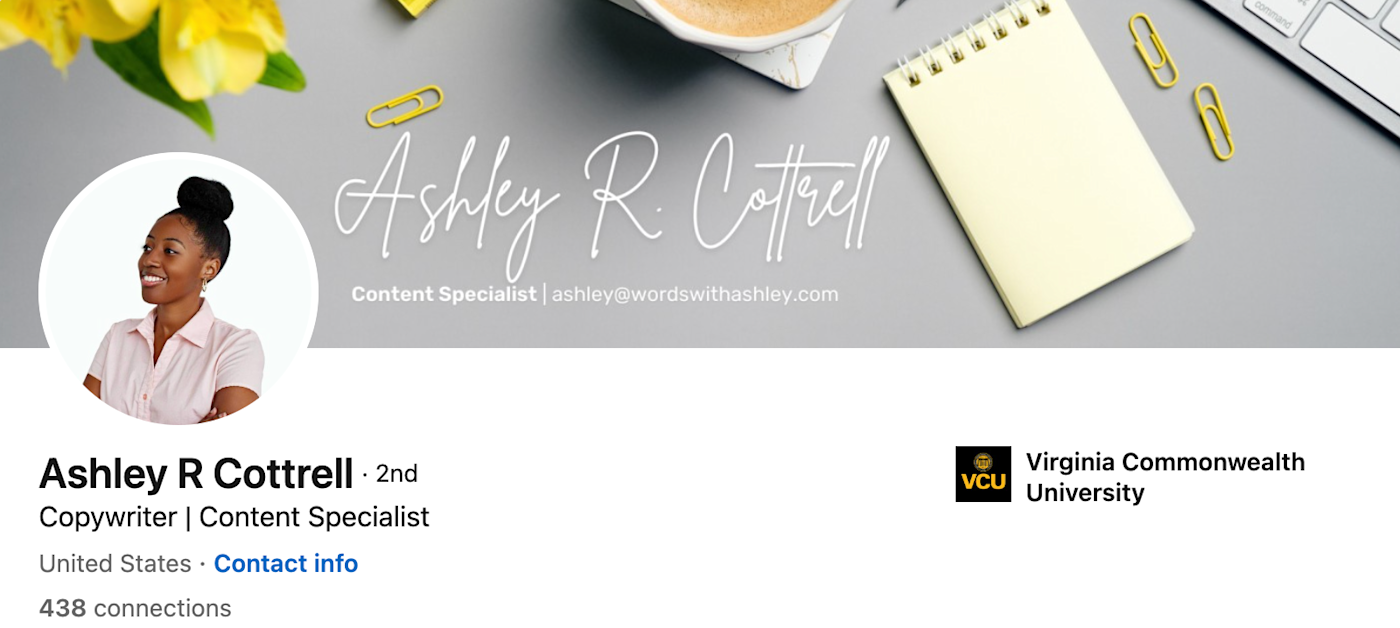
9. Your product
A LinkedIn banner is the perfect place to promote your product, what it does, and its benefits. Whether you run a small eCommerce business or work at a large tech company, this can be a great place to showcase your offerings—no LinkedIn Ad needed. If your product isn’t a physical object, you may need to get creative with this one.
In the example below, Tom Shapiro uses his LinkedIn banner to highlight his book. It’s a smart way to visually promote his product while reinforcing his thought leadership.
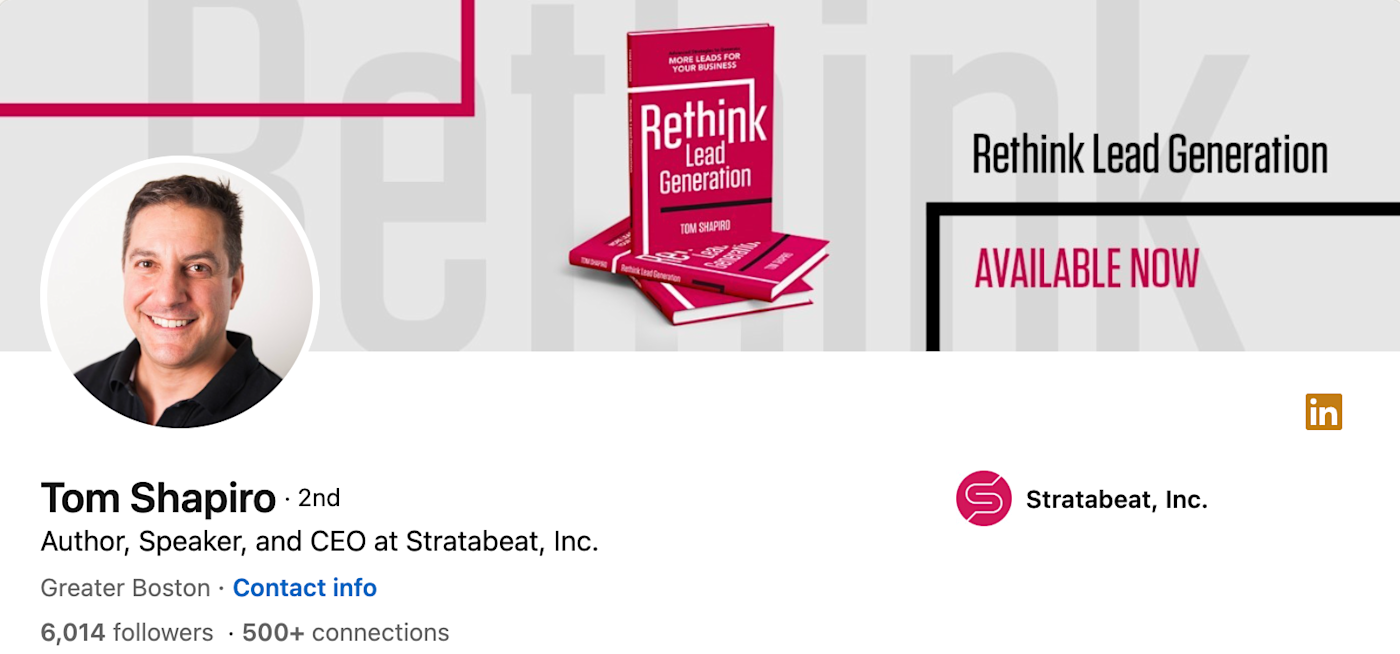
Jennifer Hood, co-founder of Hoodzpah, uses her banner to prominently display her studio’s bold, expressive typography. The repeated “Shine On” lettering in different fonts instantly communicates her branding expertise and creative range.
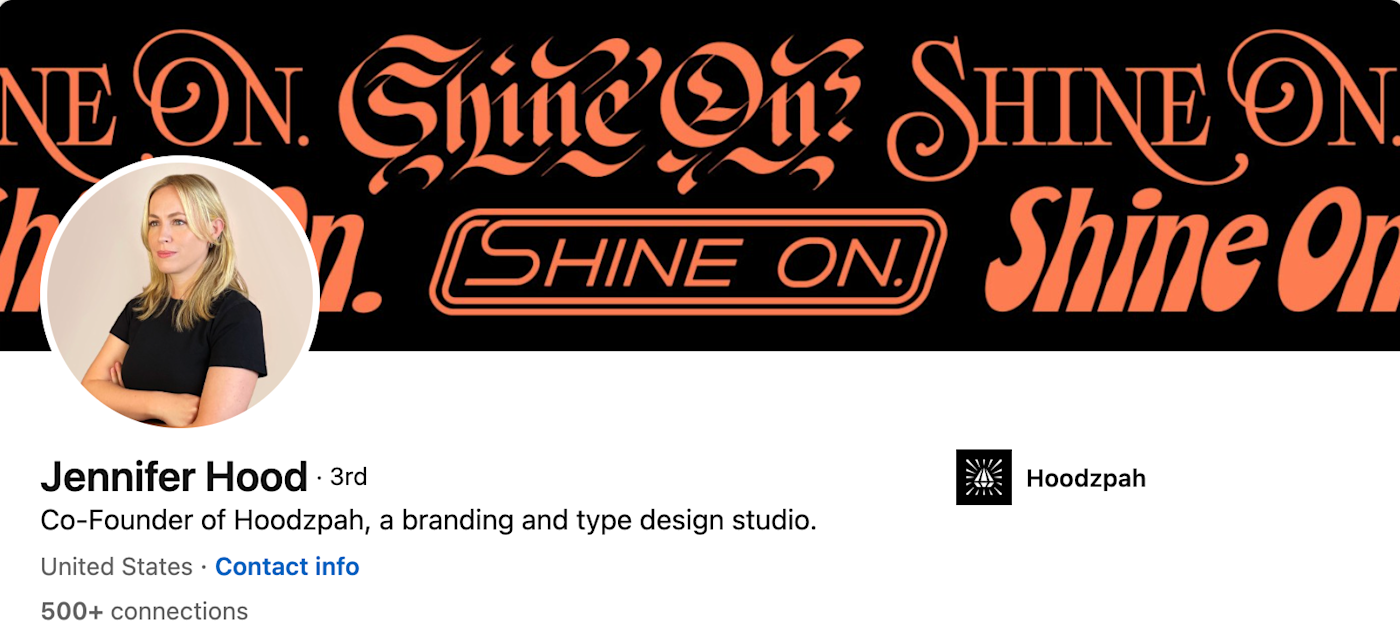
Other ideas:
-
If you’re a freelance copywriter, consider featuring brands you’ve worked with.
-
If you’re a graphic designer, showcase your designs.
-
If you’re a photographer, use a photo you took.
-
If you’re an interior designer, show off a space you curated.
-
If you work in SaaS, feature a screenshot of the product.
10. Minimalist icons
Minimalist icons are a fun and creative way to convey what it is you do in your career. Think emojis if you work in social media or a magnifying glass if you work in executive search.
In the example below, Sean, a marketing ops manager at Zapier, uses icons that clearly showcase email marketing, like an envelope, thought bubble, call to action button, and paper airplane.
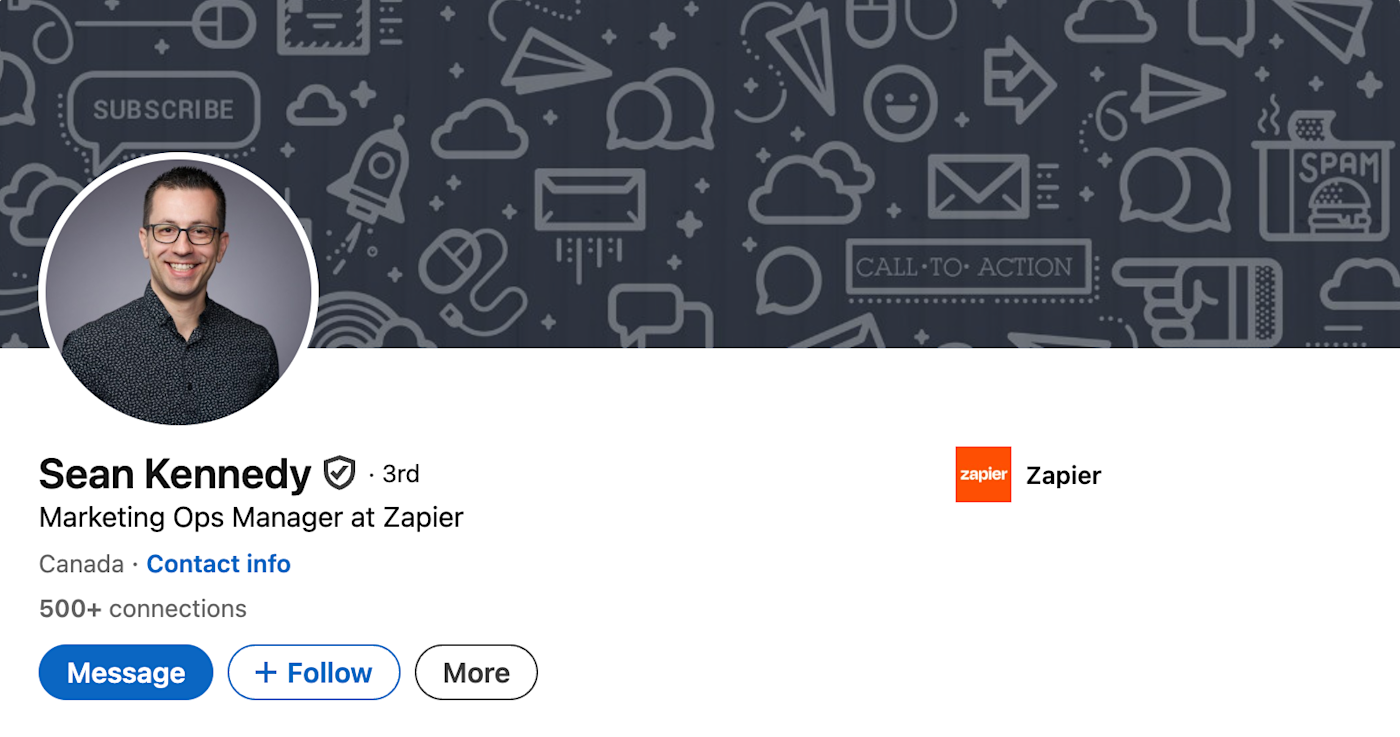
Meanwhile, Jed, a designer at Siege Media, kills two birds with one stone by using his own design skills to create these fun and colorful icons.
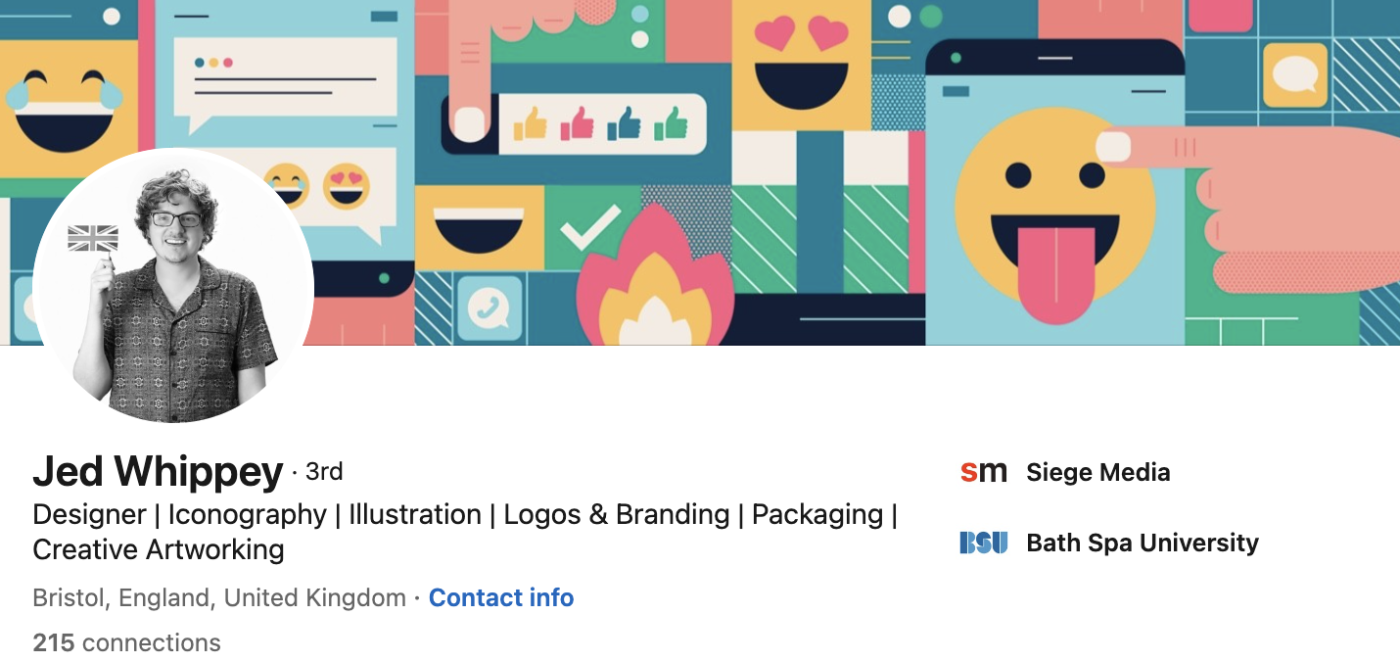
11. You doing your work
Another LinkedIn banner photo idea is to showcase yourself in action.
Lauren Soulek, a broadcast journalist at KELOLAND, gives a glimpse into her field work with a shot of her getting B-roll footage on a farm in South Dakota. Who doesn’t love a behind-the-scenes look?
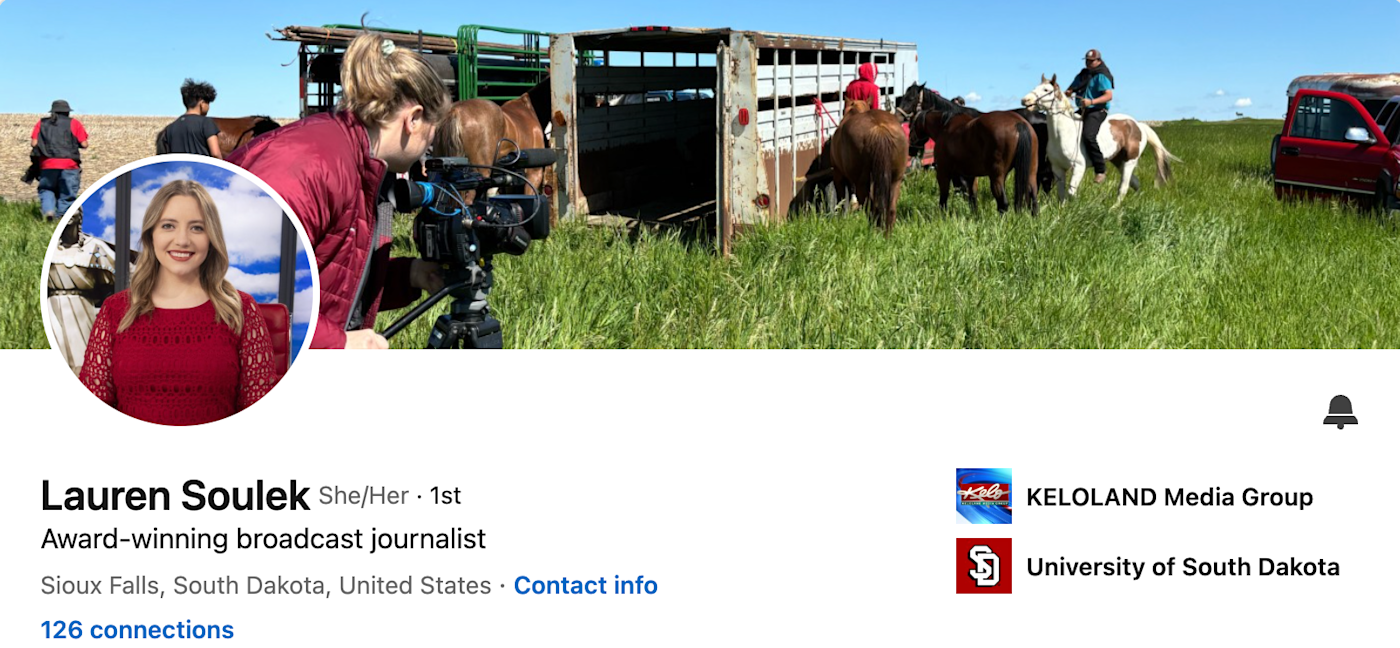
12. Personal belief
If there’s something you really believe in, don’t hesitate to display it on your profile. You won’t want to work for a company whose values don’t align with yours, so it’s actually a good way to prevent that possibility while hunting for a job. LinkedIn even offers a few pre-made banners that support causes like Black Lives Matter and LGBTQ+ allyship.
Kristina, SVP of Engineering at Afresh, selected a banner that showcases her passion for equality and human rights.
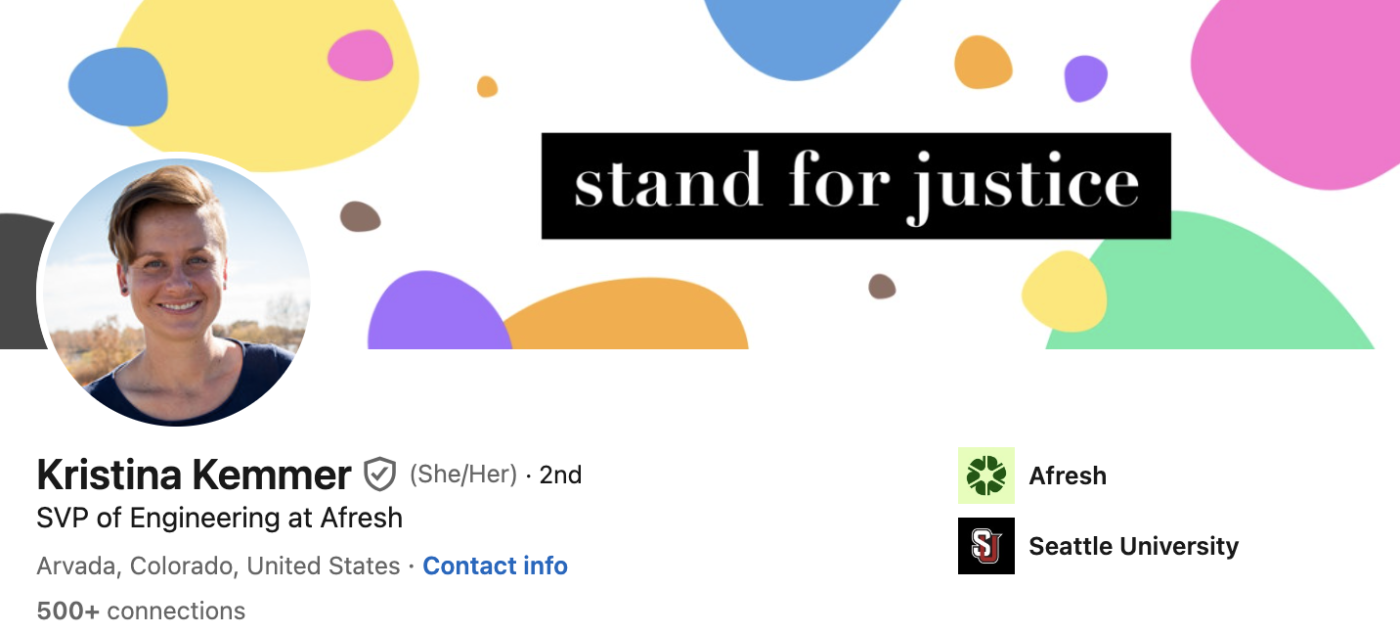
I reached out to Josh Walden, an associate attorney, about his LinkedIn banner, and he mentioned he only works with law firms that support public education. You can glean his passion for helping children by glancing at his LinkedIn banner.
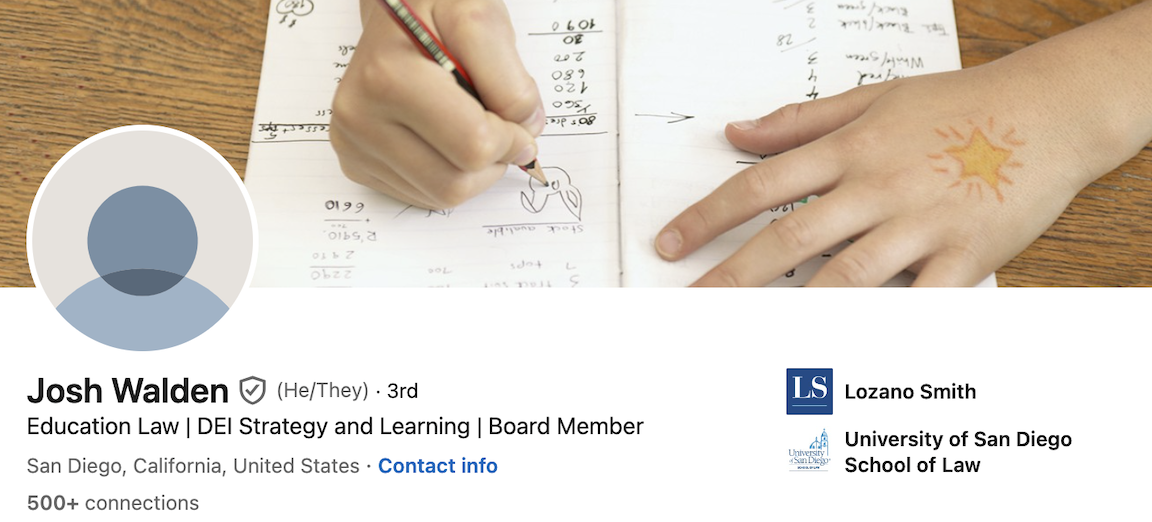
13. Your company’s logo or mission
You can promote your company by featuring your logo, mission, or another company-branded tagline. That way, potential customers or clients know exactly what you’re about from the get-go without having to go digging around your profile.
If you’re a recruiter, it’s a great way for candidates to immediately know where you’re reaching out from. And that’s exactly what Tori, a recruiter at Zapier, does.
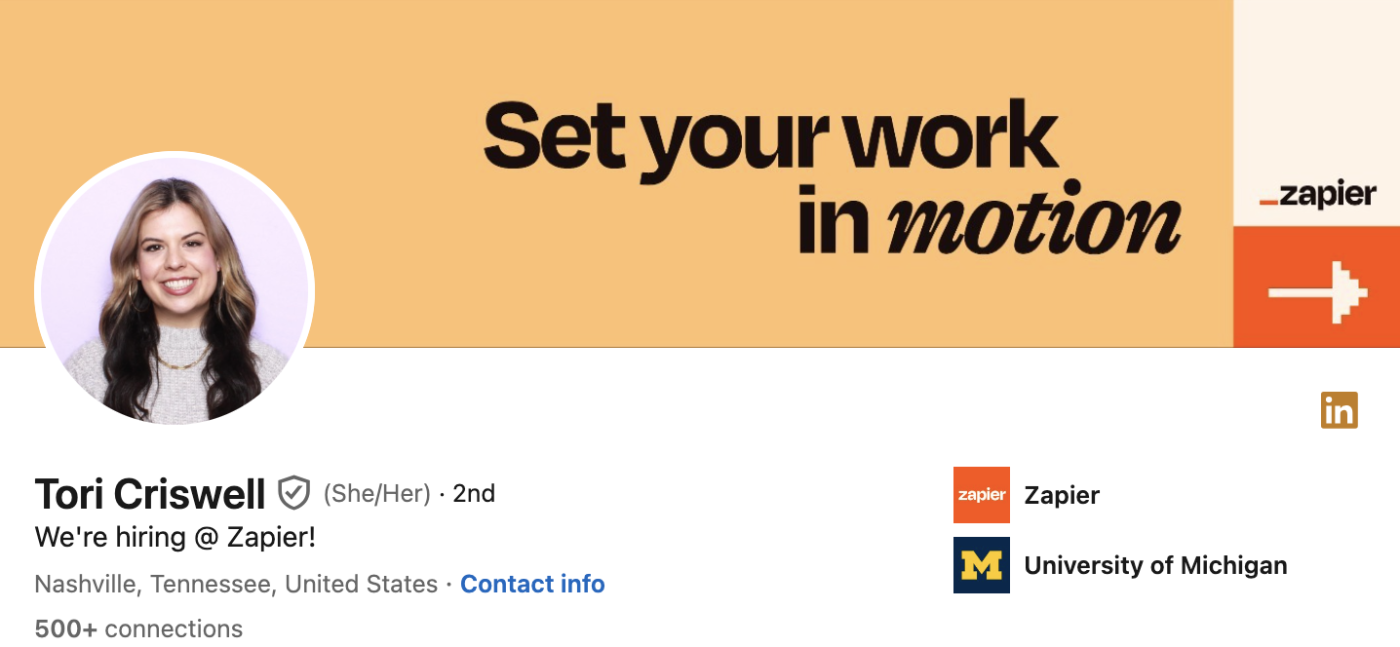
Andrew, an SEO manager at Siege Media, lays it right out there for you—if you didn’t know what Siege Media did before, you do now. (And hey: bonus city skyline!)
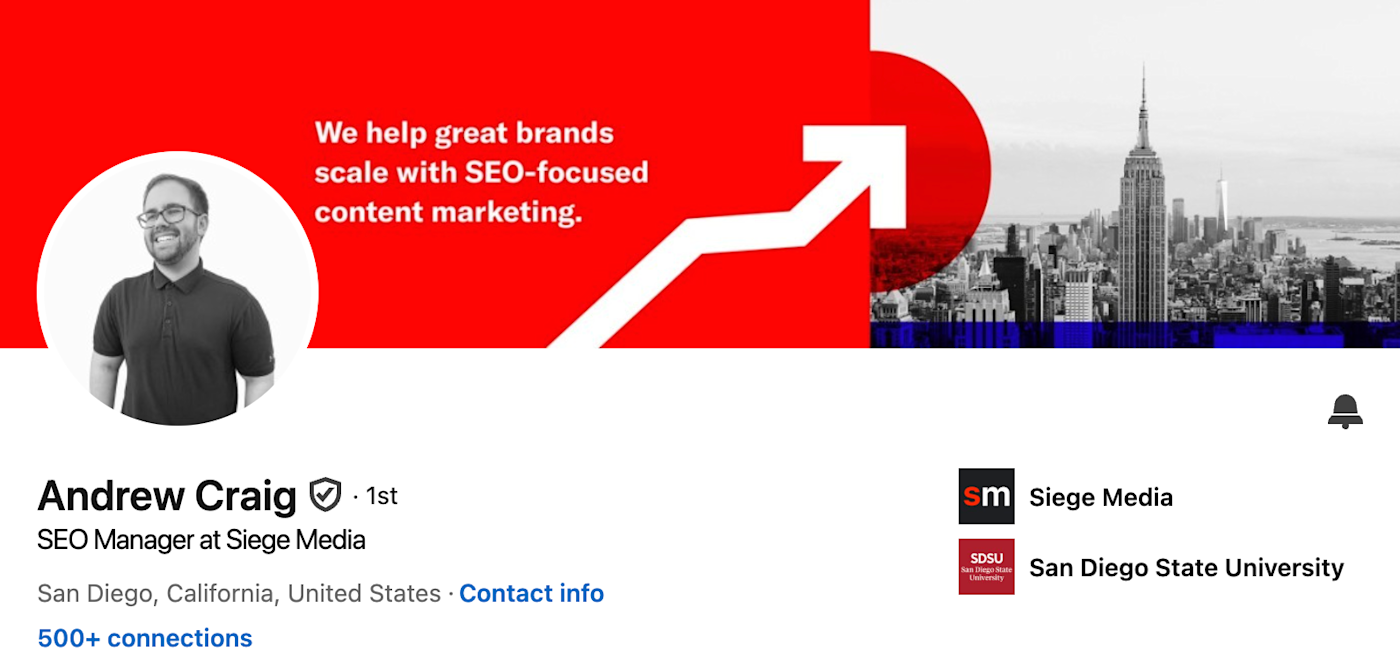
14. A solid color
Sometimes less is more. By using a solid color as your LinkedIn banner, you draw people in without distracting them. Because you want your banner to pop—but you don’t want it to overshadow the rest of your profile.
Lane Scott Jones, Director of Content & Corporate Marketing at Zapier, uses a solid orange, which just so happens to be Zapier’s brand color—win-win.
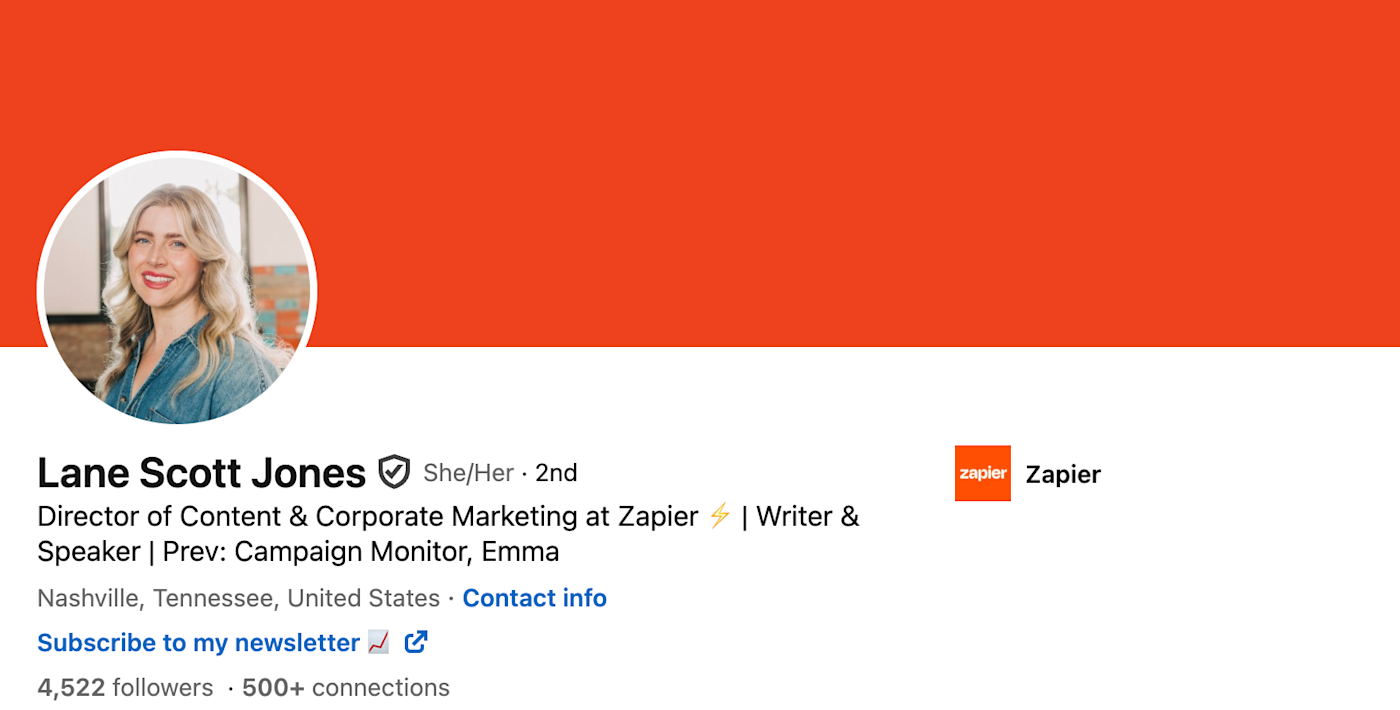
Will Harris, a content marketer, does something similar, but he goes for a more ombré look. It’s like sunset meets professionalism.
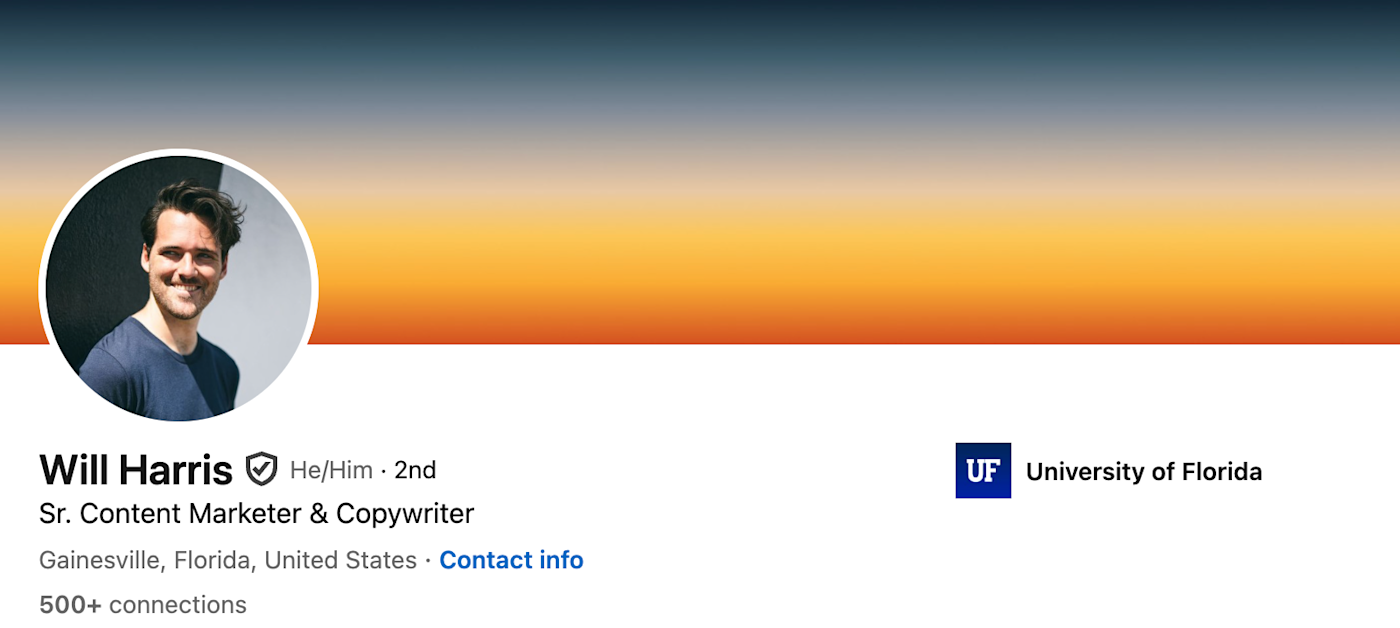
15. Social proof
Sure, you can say you’re XYZ in your LinkedIn bio, but why not show it instead? Showing tangible evidence of your skills and reputation builds credibility and trust with your audience.
Kaitlin, founder of Well Said Studio, showcases herself speaking at a conference, which implies that she’s a thought leader in the industry. (And that follower count proves it.)
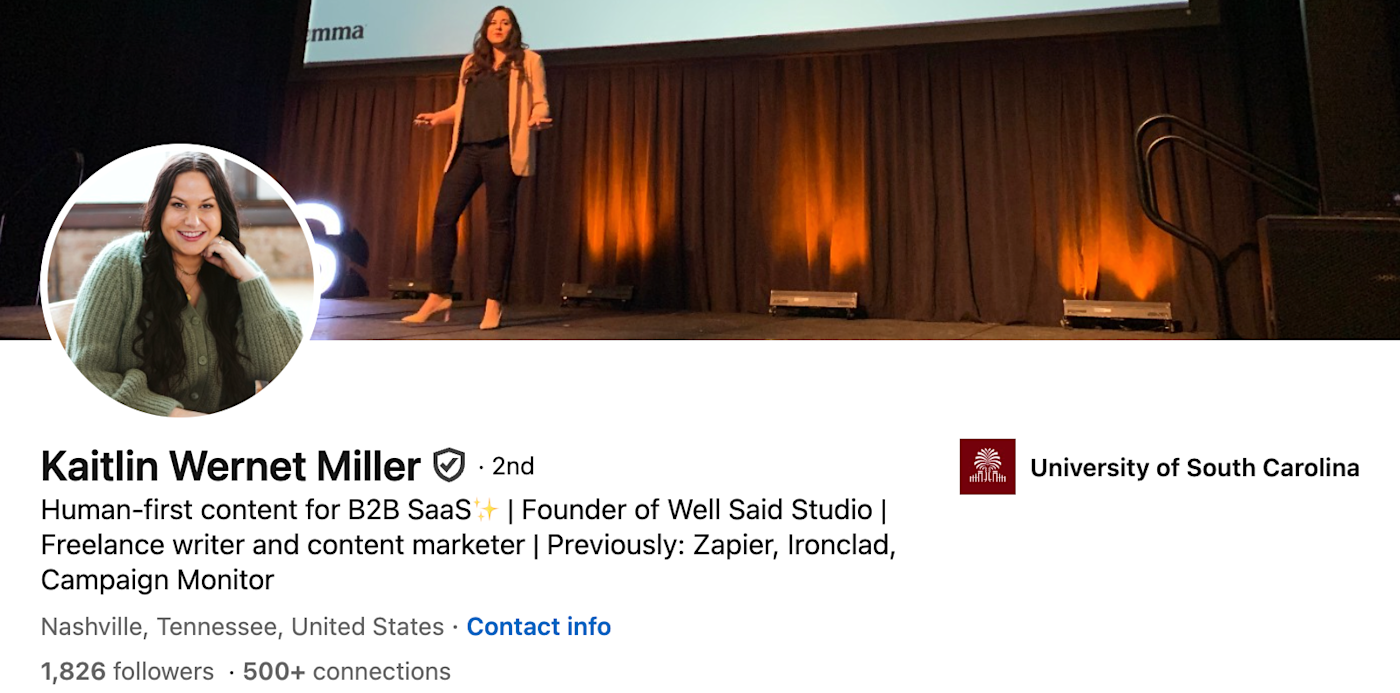
16. Testimonials
Adding real-life testimonials from former clients, peers, or managers is one way to highlight the impact of your work from the jump.
Consider featuring reputable publications where you’ve been mentioned or citing notable recent clients. Rob Hoffman, CEO of Contact Studios, does this by adding clients’ logos to his banner. Prospects can skip the visit to the company’s portfolio and move through the sales funnel faster.
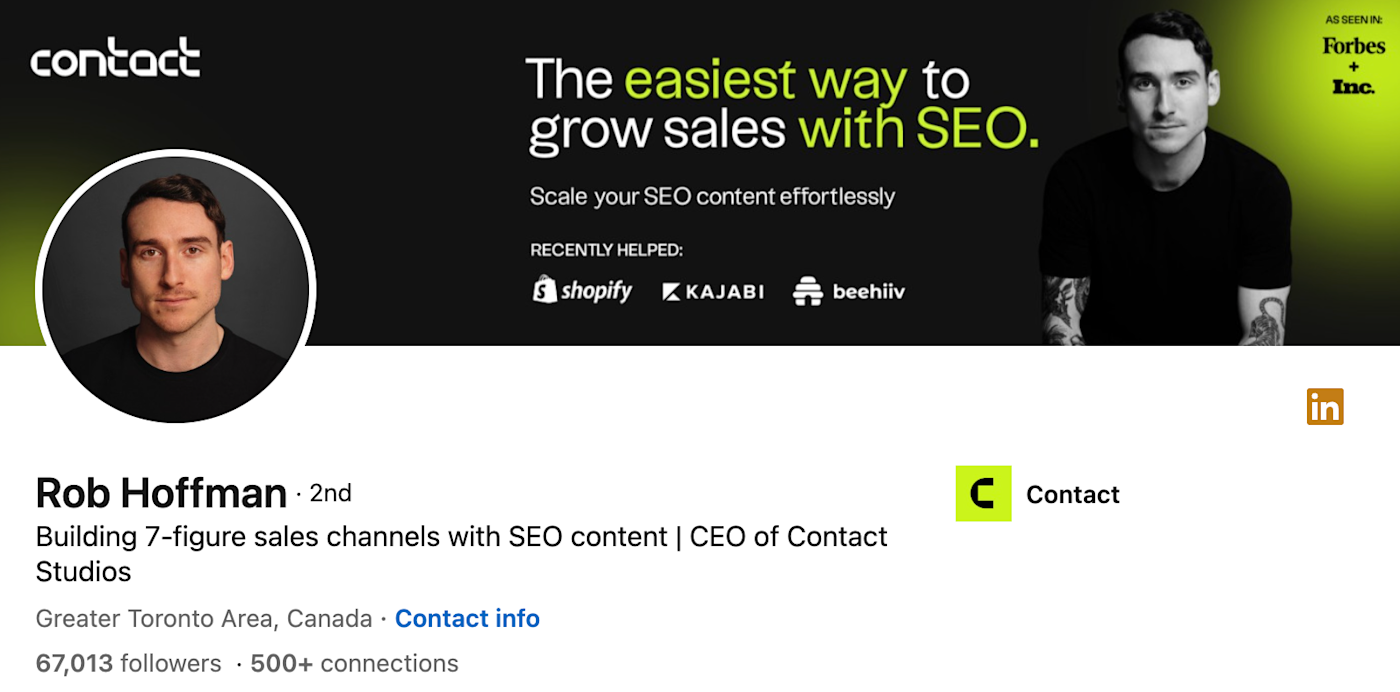
17. Call to action
Including a call to action within your banner is a great way to drive people to action. For example, Jesse McDonald, SEO strategist for Socratik, has a CTA for his next speaking event.
LinkedIn banners are generally pretty quick to create and upload, so it’s easy to swap them out to promote your latest product, a digital download, or an event you’re involved with.
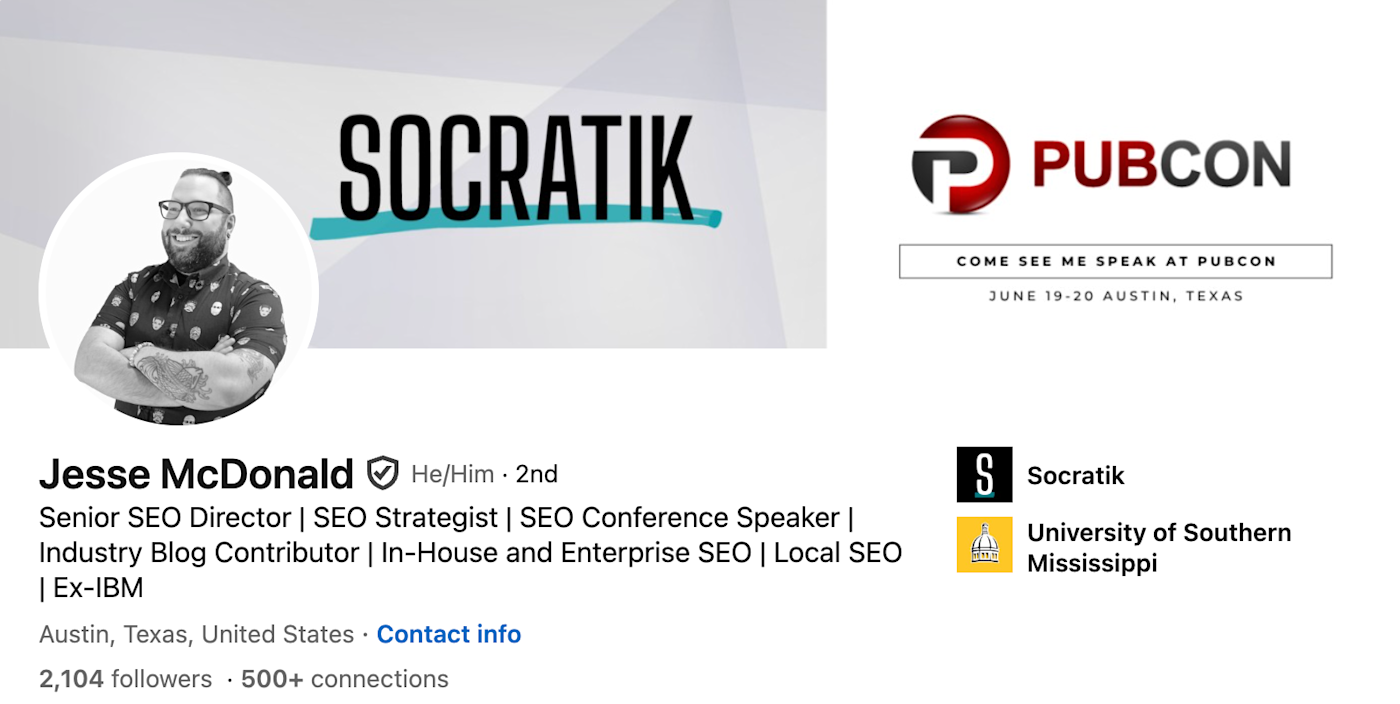
Where to source images for your LinkedIn banner
Where should you go about finding these images? Here are a few options.
-
Your own photos: Using a photo you’ve taken is probably the easiest (and most personal) way to get something up on your profile—and you don’t need to be a photographer or graphic designer to do it. Just be sure it’s decent quality and doesn’t appear blurry when you upload it.
-
Stock images: If you go the stock image route, I’d recommend sourcing from free stock image websites to be sure you’re allowed to use the photo you choose. To avoid having the same image that a zillion other people have, use more specific, descriptive words when searching, such as “minimalistic green desk” or “black and white NYC skyline.”
-
Graphic design platform: If you’re looking to create a customized LinkedIn banner, many design tools have templates available, so all you need to do is edit the text with your own info.
-
AI image generators: If you can’t find (or design) exactly what you’re looking for, make AI create it for you. Using an AI image generator, the only limit is your imagination.
LinkedIn banner dimensions
LinkedIn banner dimensions are 1584 x 396 pixels with a max file size of 8 MB. The size is slightly different for business profiles at 1128 x 191 pixels. When uploading your chosen banner, be sure to check how it appears on the mobile app, since the profile picture overlaps with the banner and can sometimes cut off some words.
LinkedIn banner dos and don’ts
After scanning countless LinkedIn profiles, consulting hiring specialists, and sourcing best practices from designers, I compiled some general dos and don’ts to consider when selecting a banner.
Do:
-
Feature your contact info. Having your professional contact information and specialty front and center on your LinkedIn banner makes it quick and easy for a potential client or recruiter to reach out to you.
-
Complement your profile picture. Whether you stick with the color scheme or overall aesthetic, choose a banner that complements your profile picture while still exuding your personal style to create a cohesive design and show you’ve put in effort.
-
Frequently mix it up. You can quickly and easily change up your LinkedIn banner to promote new initiatives, announce new products, or even just change it with the seasons (Halloween theme, anyone?). If you keep it topical, it shows that you’re actively cultivating your profile—that’s especially valuable to promote your personal brand or business.
Don’t:
-
Use a blurry image. Using a blurry image could convey that you don’t pay attention to the details.
-
Stick with the default setting. Even just switching to a plain background can help your profile stand out.
-
Pick something off of a Google image search. You could run into copyright issues if you pull a random photo off Google.
LinkedIn banners are a great place to showcase who you are so you can connect with others. And isn’t that what LinkedIn is all about?
Automate your LinkedIn presence with Zapier
Just as a creative LinkedIn banner idea can enhance your profile, social media automation can boost your LinkedIn promotion and professional development efforts.
You can use Zapier to streamline your LinkedIn activities, connecting LinkedIn to all the other apps you use. Automate things like sharing company updates from RSS feeds, updating your company page when you post to other social channels, publishing new blog posts to your LinkedIn feed, and even sharing new content with AI. Learn more about how to automate LinkedIn, or get started with one of these pre-made workflows.
Zapier is the most connected AI orchestration platform—integrating with thousands of apps from partners like Google, Salesforce, and Microsoft. Use interfaces, data tables, and logic to build secure, automated, AI-powered systems for your business-critical workflows across your organization’s technology stack. Learn more.
Related reading:
This article was originally published in December 2022 and has since had contributions from Deb Tennen, Cecilia Gillen, and Allisa Boulette. The most recent update was in July 2025.